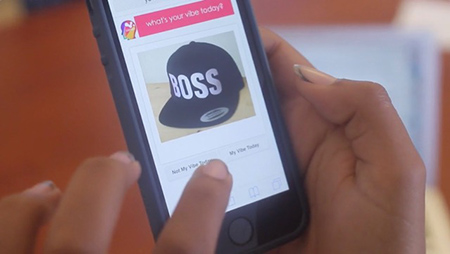Measuring social and emotional wellness? There's an app for that

Shawn Ginwright, an associate professor of Africana studies at SF State, has created an app to measure youth's social and emotional wellness.
Your smartphone's screen fills with an image of a man standing alone in a doorway, his body casting a long shadow. "What's your vibe today?" the app asks. Tapping buttons, you indicate whether or not this image and a subsequent series of photos represent how you're feeling. At the end, your reward is a colorful slideshow that reflects your state of mind.
The app is Vibosity -- and while it's designed to be fun, it is not actually a game. It's a tool for measuring social and emotional wellness created by Shawn Ginwright, associate professor of Africana studies at San Francisco State University, and the team at his Oakland nonprofit Flourish Agenda.

Vibosity users respond to the question "What's your vibe today?" in order to measure their current state of mind.
Vibosity is designed to function as an alternative to the monotonous pencil-and-paper assessment forms currently used in schools, one that actually engages students and reflects their interests, Ginwright said. It was inspired by his own children's passion for technology.
"When young people talked to us about assessments, they said, 'It's boring. I don't want to do it.' The question becomes, 'Is the data that we are getting actually accurate, or are students just bubbling stuff in to get it done?'" Ginwright said. "We're trying to assess social and emotional health, and we don't want kids to be miserable in the process."
By having students and teachers use the app on a regular basis, school administrators can gauge the social and emotional welfare of their campus population as a whole and track how it changes over time.
Ginwright's goal is to help address a problem he understands all too well after working with Oakland youth for more than 25 years: No matter how strongly schools emphasize academics, the trauma and hopelessness faced by many students create insurmountable barriers to their success.
"There are dimensions of education that get overlooked, and as a result we never achieve the academic outcomes that we seek," he said. "In many urban communities where young people experience trauma and poverty, schools should be as much about healing as they are about education."
Because a school's aggregate Vibosity score is broken down into categories, administrators can see if students are experiencing mood changes related to a specific area, such as culture, achievement or relationships, and develop targeted interventions, Ginwright said.
Ginwright also offers insights about the kinds of healing strategies that schools can implement to empower young people. His newest book, "Hope and Healing in Urban Education: How Urban Activists and Teachers Are Reclaiming Matters of the Heart," recently released, presents case studies about teachers who have found innovative ways to change the lives of the young people they serve.
"I've been deeply engaged in this work for over 25 years, and I've seen the power of restorative relationships and how those relationships can really change the trajectory of young people's lives," Ginwright said. "I wanted to highlight how people are doing that."
Vibosity has been piloted at a few schools and youth programs, and Ginwright and his team are in talks with schools across the country that are interested in adopting the app into their curriculum.
"This isn't just a problem in Oakland, this is a national crisis," Ginwright said. "We have to begin to place healing at the center of our educational and political strategies."
With Vibosity, Ginwright hopes to take that vision one step closer to reality.